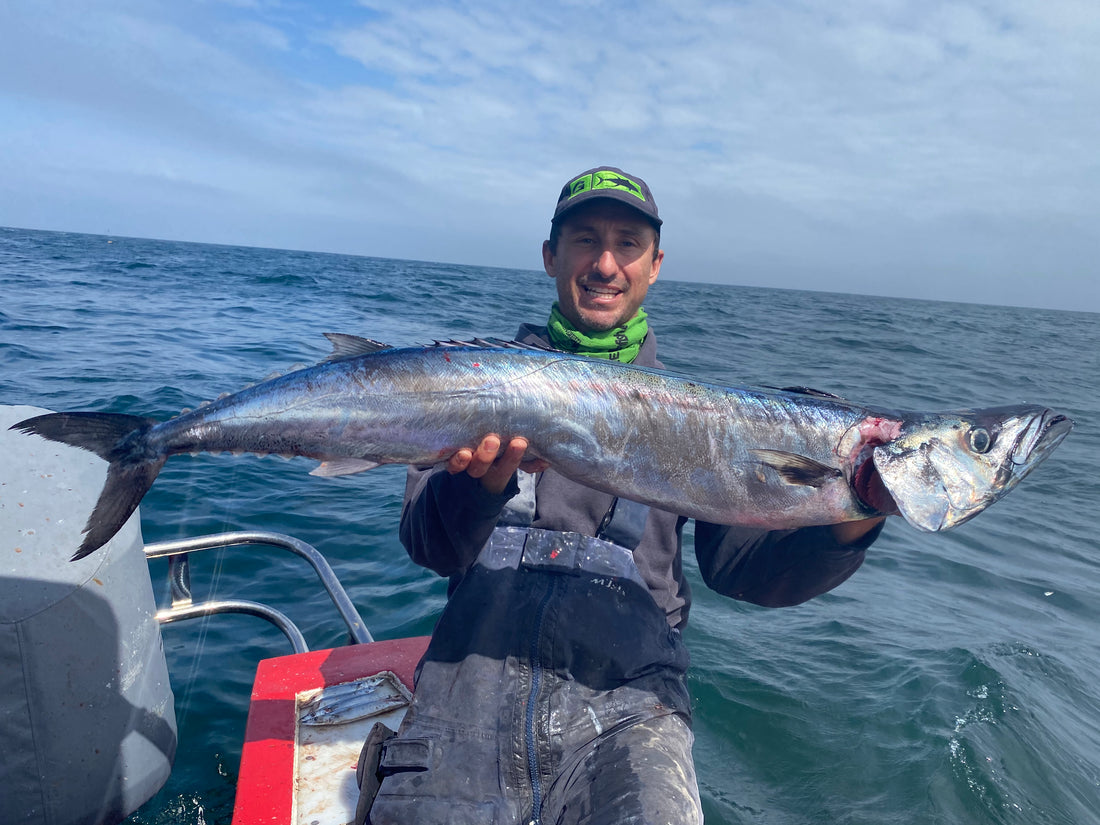
Snoek Blog
Share
Snoek
Snoek fishing is where I started making pocket money as a school boy in Table Bay. It is a tradition and starting point for most handline fishermen on the west coast, and the “Snoek run” is synonymous with the South African fishing industry. Little did I know at the time that this would become the early foundations of Greenfish.
Snoek is a staple income for many of the coastal communities. More boats go out to target this species than any other species in the Western Cape. The local jobs created are tenfold and the secondary job creation is clearly evident, from the people who offload, to the ladies that fleck in the harbour, the hawkers that transport and sell on the streets, to the fish and chips shops and retails stores that supply the public.
This fantastic sustainable hand line fishing is highly selective and has little to no by catch. Its low intensity method of catch means only a portion of the school of snoek is caught, limiting fishing pressure and supporting healthier stocks for the future. More jobs are created per a ton of fish caught in this manner than some of the larger factory trawler type vessels. Snoek fishing is of cultural significance and many families have passed down boats and skills for generations, as well as empowering local ownership and embracing coastal operators to be custodians of their resources.
Snoek, with their fast growth rates, lend themself to be a resilient contender to fishing pressures but they are not invincible. Large vessels with massive nets trawl indiscriminately and catch masses of bait fish (that start the oceans food cycle) and other species. This includes fish and other marine life which are not targeted and often discarded dead at sea. This type of behaviour needs to change. Weather and water temperatures are also changing, which can limit the food on which predator fish such as snoek feed on, changing catch areas.
With the changing “snoek run” seasons some retailers import “barracouta” from New Zealand and sell it locally under the name snoek. It is therefore always advisable to ask where and how your fish was caught so you can make an informed choice.
This year the snoek has started in St Helena Baai and we expect catches to fluctuate between there and Lambersbaai and as far north as Port Nolloth. Many fishermen from Table Bay, False Bay and Gaansbaai will migrate up the coast to catch these fish, that were once coming to their doorstep, to make a living.
What is a pap snoek?
A pap snoek is the result of breakdown of the flesh of the snoek, caused from what we believe to be an enzyme that the fish releases as a form of herd protection as it shakes off its scales while being caught. This is thought to be done in an effort to distract larger predators attacking the school.
About 8-9% of all local snoek caught are pap. We know this because when we fleck them, we take out the pap ones before salting, wrapping and freezing the good ones for distribution. The pap snoek are made into salted snoek and sold separately.
The chances that you will receive a bad snoek from Greenfish is very slim, as we hand cut and evaluate each fish on an individual basis.
Lekker Snoek on the Braai.
Snoek has a very unique strong flavour, it is easily identified by its long bones, and mostly eaten by hand. Filleting of a snoek is called “flecking” and the cut looks like a butterfly cut. The fish is lightly salted before been rinsed off as a way of extracting excess water out the flesh. This is called mild curing. Mild cured snoek need not have salt added when cooking.
We trust The Fish Wife to tell us how to cook a snoek the traditional way with apricot jam. https://fishwife.co.za/braaid-snoek-with-sticky-apricot-jam-chutney/
Order yours today at greenfish.co.za

3 comments
I am from Ladismith w cape. Do you distribute your snoek in our direction as the snoek I bought in Mosselbaai was pap and I only discovered that after a braai at home.
Good morning, I would like to place an order for big fresh snoek to be delivered.
Delivery date 22, Sept.
Please let me know how to go about it.
Thank you
Maud
Although I am aware of Pap snoek, I now have to query whether you can encounter this in other fish as well? I ask because I have pap elf …all four of them!
Caught two days ago in very warm water for Namibia, chart says 19 but feels decidedly more like 22C.
Fish were caught wading on rock ledges….fish necks were broken and keep in crayfish bag strapped to my side and were under water 90% of the time. Fishing time was 1.5 hours after which we went home, 10 minute drive, and then fish were frozen whole.
two days later de frosted en voila ..PAP!
Any ideas…a perusal of the net has not given any satisfactory answer…only snoek…
Much appreciated
Mike n Sonja Thygesen
Swakopmund